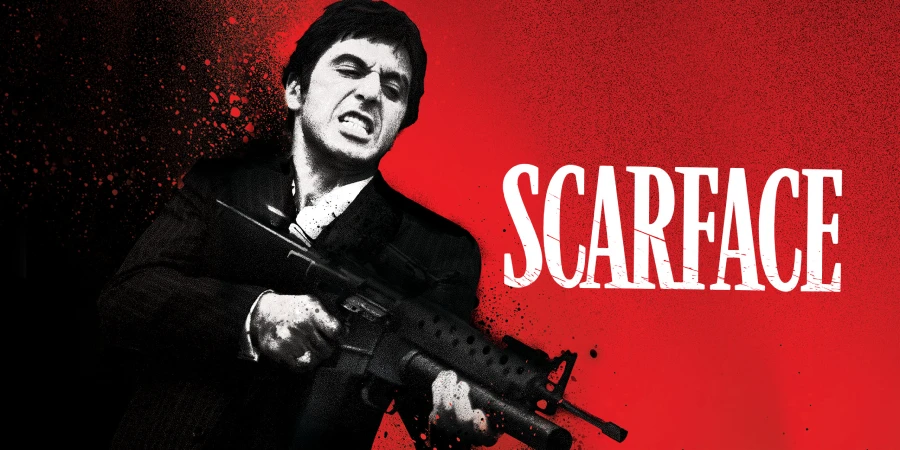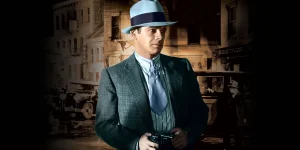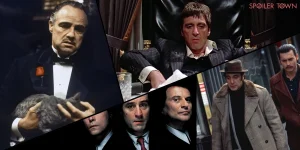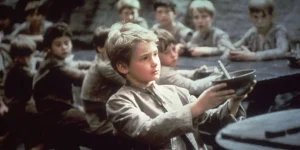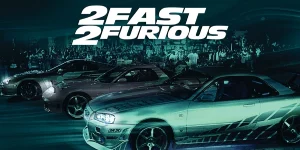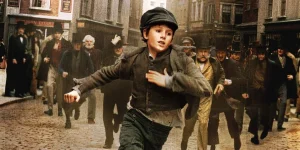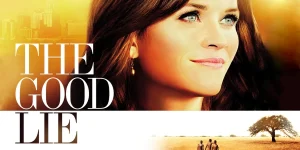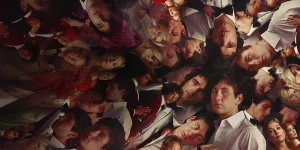Brian De Palma’s Scarface (1983), written by Oliver Stone and starring Al Pacino, is one of the most iconic crime dramas ever made. Loosely inspired by the 1932 film of the same name, it reimagines the story in the context of 1980s Miami, drenched in neon lights, drug trafficking, and brutal ambition.
Below is an in-depth breakdown of the film, its themes, behind-the-scenes stories, memorable moments, and much more.
Table of Contents
ToggleDetailed Summary
From Refugee to Gangster
The movie begins with the real-life Mariel boatlift of 1980, where Cuban refugees were allowed into the United States. Among them is Tony Montana, played with volcanic intensity by Al Pacino. Tony claims he wants to live the American Dream, but it’s clear from the outset that he wants more—more money, more power, more control.
Tony quickly shows his ruthless side, killing a political dissident in exchange for a green card. This act foreshadows his violent climb to power.
The First Break: Chainsaw Scene
One of the film’s most shocking early sequences takes place in a Miami motel, where Tony and his friend Angel are set up in a drug deal gone wrong. The infamous chainsaw scene, still talked about decades later, is a gruesome introduction to the world Tony is entering. It’s also the moment he first truly proves himself, walking away with both drugs and money after a bloody shootout.
Rise in the Ranks
Tony works his way up through the ranks of Frank Lopez’s drug empire. He is brash, violent, and disobedient—but he gets results. He begins to covet Frank’s empire, and his woman, Elvira Hancock (Michelle Pfeiffer in a career-defining role).
After a failed assassination attempt ordered by Frank, Tony kills both Frank and the corrupt cop protecting him, officially seizing control of the empire. He marries Elvira and builds a palatial mansion. He’s on top—but the cracks begin to show.
The Price of Power
Despite all the wealth and influence, Tony becomes paranoid, erratic, and increasingly isolated. His marriage with Elvira collapses under the weight of cocaine, arguments, and control issues. He also becomes obsessively protective of his sister Gina, which leads to tension with his best friend Manny, who secretly loves her.
Tony’s refusal to carry out an assassination of a journalist (because it would also kill innocent civilians) puts him at odds with a powerful Bolivian drug lord, Alejandro Sosa, who sees Tony as a liability.
Movie Ending
The ending of Scarface is as operatic and brutal as any in cinematic history.
Tony returns home to his mansion after a night of rage and despair, only to be told that Gina has eloped with Manny. In a blind, jealous fury, he kills Manny, only to realize seconds later that they were married and in love. Gina’s grief and anger shake him—but it’s too late. He has destroyed the people closest to him.
While Tony drowns in guilt and cocaine, Sosa’s men raid the mansion. In the now-iconic final shootout, Tony arms himself with a grenade launcher-equipped M16 and screams, “Say hello to my little friend!”, mowing down attackers in a cocaine-fueled frenzy. He kills dozens, seemingly invincible, until one of Sosa’s hitmen sneaks in behind him and shoots him in the back.
Tony’s body falls from his balcony into a fountain below, underneath a statue that reads “The World is Yours.”
It’s a tragically ironic ending—he gets everything he wants, only to lose it all.
Are There Post-Credits Scenes?
No. Scarface does not have a post-credits scene. The film ends definitively with Tony’s death, and the credits roll in a stark, sobering silence. No teasers. No epilogues. Just the fall of a king who built his empire on blood and cocaine.
Type of Movie
Scarface is a crime drama and gangster film, with strong elements of psychological thriller and tragedy. It’s a rise-and-fall story in the tradition of classic gangster tales, with a hyper-violent, drug-fueled 1980s edge.
Cast
- Al Pacino as Tony Montana
- Michelle Pfeiffer as Elvira Hancock
- Steven Bauer as Manny Ribera
- Mary Elizabeth Mastrantonio as Gina Montana
- Robert Loggia as Frank Lopez
- F. Murray Abraham as Omar Suarez
- Paul Shenar as Alejandro Sosa
Film Music and Composer
The score was composed by Giorgio Moroder, a pioneer in electronic music. His synth-heavy soundtrack captures the neon-lit 1980s Miami aesthetic perfectly. The song “Push It to the Limit” is still a pop culture staple and often used in parodies and homages.
Filming Locations
- Miami, Florida – Used for exterior shots and beach scenes. However, due to political backlash, most of the film was actually shot elsewhere.
- Los Angeles, California – Much of the film, including Tony’s mansion, was filmed in and around LA due to threats from Cuban-American groups who protested the film’s portrayal of Cubans.
The change in filming location gave the movie a slightly artificial, hyper-real quality—which many believe added to its stylized feel.
Awards and Nominations
At the time of release, Scarface received mixed reviews and was even nominated for three Razzie Awards, including Worst Director. However, it was later reevaluated and is now considered a cult classic.
Modern accolades include:
- Named one of AFI’s Top 10 Gangster Films
- Frequently listed in “Greatest Movie Quotes” lists
Behind the Scenes Insights
- Al Pacino burned his hand during the shootout scene when he grabbed a still-hot gun barrel.
- Michelle Pfeiffer was starving herself during filming to maintain Elvira’s slim figure; she later admitted it was dangerous to her health.
- Oliver Stone wrote the screenplay while battling cocaine addiction, which deeply informed the tone and themes of the film.
- Brian De Palma used over 200 squibs in the final shootout—one of the bloodiest scenes filmed at the time.
Inspirations and References
- Loosely based on the 1932 film Scarface, which itself was inspired by Al Capone.
- Influenced by real-life events in the Miami drug wars of the 1970s and 1980s.
- The phrase “The World is Yours” is a direct nod to the original film and represents the hollow promise of unlimited ambition.
Alternate Endings and Deleted Scenes
There are no known alternate endings, but the chainsaw scene was heavily edited for TV and some theatrical cuts due to graphic violence. A few extended sequences, including more scenes of Tony’s drug empire expanding, were cut for pacing.
Book Adaptations and Differences
While not based on a book, Scarface inspired numerous novelizations and unofficial sequels in print form. The story differs significantly from the 1932 film—swapping Italian-American gangsters for Cuban exiles and Prohibition for the cocaine boom.
Memorable Scenes and Quotes
Key Scenes
- Tony confronting Frank Lopez and taking over the empire.
- The chainsaw motel scene.
- Tony yelling at Elvira in the restaurant: “Take a look at the bad guy.”
- Gina’s breakdown and death in Tony’s mansion.
- The final “Say hello to my little friend!” showdown.
Iconic Quotes
- “Say hello to my little friend!”
- “In this country, you gotta make the money first. Then when you get the money, you get the power. Then when you get the power, then you get the women.”
- “I always tell the truth. Even when I lie.”
- “The world is yours.”
Easter Eggs and Hidden Details
- The “World is Yours” blimp is a reference to both the 1932 Scarface and the illusion of the American Dream.
- Tony’s office globe statue mirrors his ambition—reaching for the world, yet surrounded by enemies.
- Tony’s mansion is decorated in blood red, symbolizing the violence that built it.
Trivia
- Pacino modeled Tony’s accent on a Cuban boxer he met in Miami.
- The “F-word” is used over 200 times.
- The film was banned in some countries upon release due to excessive violence and language.
- It inspired countless rappers, including Jay-Z and Nas, who frequently reference Tony Montana.
- The original critical reception was harsh, but the film has grown into a cult legend.
Why Watch?
If you’re into gangster films, gritty character studies, or simply want to see one of cinema’s most iconic anti-heroes, Scarface is a must. It’s a brutal, brilliant exploration of ambition, identity, and downfall, wrapped in stylish direction and a legendary lead performance.
Director’s Other Movies
- Carrie (1976)
- The Untouchables (1987)
- Carlito’s Way (1993)
- Blow Out (1981)
- Mission: Impossible (1996)

